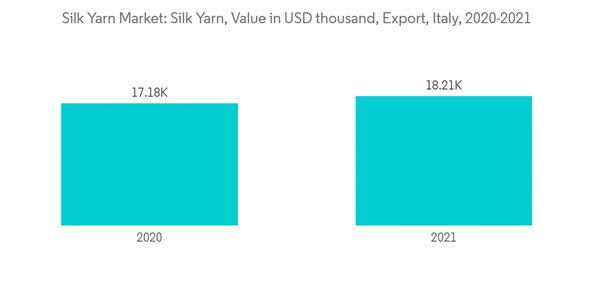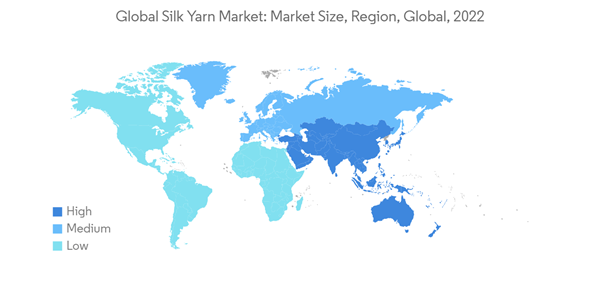Key Highlights
- The industrialization of the silk industry coupled with various government schemes will boost the production of raw silk in the Asia-pacific region which in turn increase the production of silk yarn making the region to be the largest market during the forecast period.
- Caribbean countries such as Cuba and African Countries including Kenya are making an effort to boost their silk yarn production.The Government of Rwanda as well as has begun investing in the development of silk value chains, with the rising demand from Asia, the production of high-quality silk products offers strong export opportunities. To tap into growing global markets, Rwanda's National Agricultural Export Development Board (NAEB) has also partnered with HEWorks, a Korean silk manufacturer.
- The sector is a major provider to foreign exchange reserves in nations such as India which is why the government supports with various initiatives to boost the industry. In India, sericulture operations are distributed throughout 52,360 villages. The country uses raw materials to manufacture silk garments, made-ups, textiles, yarns, carpets, shawls, scarves, pillow coverings, and accessories.
- Countries such as India, China, the United States of America, Italy, France, Switzerland, Japan, Vietnam, the United Arab Emirates, the United Kingdom, Germany, and Korea are some of the major consumers of silk and silk products. The industrialization of the silk industry coupled with various government schemes will boost the production of raw silk in the Asia-pacific region which in turn increases the production of silk yarn, making the region to be the largest market during the forecast period.
Silk Yarn Market Trends
Italy is Emerging as Major Producer of Silk Yarn in Europe
Italy is one of the major producers of silk yarn in the European region, as hundreds of farms have started rearing silkworms in the past few years. Silk production using silk worms grown in Italy has been on the rise in recent years. Comapnies such as ONGETTA SRL is specialized in the silk throwsting and produces GOTS certified organic silk that is branded ONGETTA BIO SILK. It was the first spinning and twisting mill of GOTS certified silk yarns in Europe.The decrease in exports of silk yarn from China is likely to give more access to the Italian silk yarn producers to the global market. Further, the price of Chinese silk has been climbing, far surpassing the price of silk threads produced in Italy from Italian-grown silkworms. This would further boost domestically produced silk yarn.
However, the production and export of silk yarn from Italy are minuscule when compared to Chinese production and export of silk yarn. In 2021, Italy exported silk yarn which valued at USD 18,214 thousand worldwide, which have increased by 8% as compared to 2020 and the major destinations were France, Romania, United Kingdom, Austria, and Germany.
Asia Pacific Dominates the Market
China is worlds largest producer and export silk and silk products including silk yarns. However, the rising costs of mulberry cultivation are forcing many farmers to exit sericulture.Silk is mainly produced in the south of the Yangtze River Delta. Renowned silk producing regions are Jiangsu, Zhejiang and Sichuan provinces. Cities such as Suzhou, Hangzhou, Nanjing, and Shaoxing are well known for their silk industries.Uzbekistan is another prominent producer of silk. The silk products of the country are highly valued in the global market. In the nation, the organisation "UZBEKIPAKSANOAT" was founded recently. The organisation is working hard to improve silkworm cocoon production, as well as silk fabric processing and manufacturing. Collaboration with local and worldwide manufacturers is underway, and self-employed silk producers are encouraged and supported. After China and India, Uzbekistan is the world's third largest producer of silk.
India has implemented a scheme called Silk Samagra through its Central Silk Board (CSB) to enhance the quality and productivity of domestic silk to reduce the country's import of raw silk. In order to promote tussar silk cultivation in Odisha, the Khadi and Village Industries Commission (KVIC) in has recently established the State's first silk yarn production centre at Choudwar in the district .The industrialisation of the silk industry coupled with various government schemes will boost the production of raw silk in the Asia-pacific region which in turn increase the production of silk yarn making the region to be the largest market during the forecast period.
Silk Yarn Industry Overview
Additional Benefits:
- The market estimate (ME) sheet in Excel format
- 3 months of analyst support
This product will be delivered within 2 business days.










